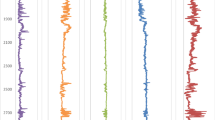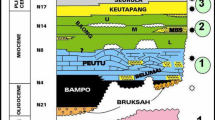Abstract
Detailed subsurface modeling, help safe and cost-effective operations. The proposed model by integration of geological data, petrophysical data, and geomechanical model allowed for better reservoir characterization, development, and management. Well data such as leak-off test or mini-frac and image logs are found essential for constructing the geomechanical model. Since these data are rarely available, the geomechanical unit (GMU) concept is used in this study to cover such a gap. Based on facies index (percentage of grains, cement, dolomite, matrix, or microporosity), uniaxial compressive strength (UCS), and porosity, the studied formation was divided into five GMUs. From GMU1 to GMU5, the amount of cement and dolomite, UCS, cohesion, friction angle, fracture toughness, and brittleness increase, whereas porosity, bioclasts/grains, and clay content decrease. Optimization of geomechanical model by GMU concept was caused to show a good correlation between GMUs distribution and breakouts and breakdowns of the studied well. The GMU1 and GMU2 were found more susceptible to breakout, the GMU4 and GMU5 more susceptible to breakdown, while the GMU3 contains both breakdown and breakout zones. For a safe drilling in the studied formation, the highest breakout pressure (11.5 ppg) was observed for the GMU1 and GMU2 and the lowest (8 ppg) was seen for GMU4 and GMU5. The results of this study may help in designing, based on optimized geomechanical units, and safe mud weight window for drilling in heterogeneous reservoirs.





















Similar content being viewed by others
Change history
25 June 2022
A Correction to this paper has been published: https://doi.org/10.1007/s10064-022-02788-8
Abbreviations
- GMU:
-
Geomechanical unit
- UCS :
-
UNIAXIAL COMPRESSIVE STRENGTH
- Ppg :
-
Pounds per gallon
- DSI :
-
Dipole sonic imager
- CT :
-
Computer tomography
- FI :
-
Facies index
- K IC :
-
Fracture toughness
- Vs :
-
S-wave velocity
- Vp :
-
P-wave velocity
- SCB :
-
Semi-circular bend
- BI :
-
Brittleness index
- MRGC :
-
Multi regression graph base clustering
- MEM:
-
Mechanical earth model
- C :
-
Cohesive strength
- φ :
-
Internal friction angle
- \({\sigma }_{v}\) :
-
Vertical stress
- \({\sigma }_{h}\) :
-
Minimum horizontal stress
- \({\sigma }_{H}\) :
-
Maximum horizontal stress
- P pg :
-
Pore pressure gradient
- MW :
-
Mud weight
References
Aadnoy B, Looyeh R (2019) Petroleum rock mechanics. Elsevier, 2nd Edition, 460 pp
Adabnezhad P, Aghighi MA, Kadkhodaie A, Rostami A (2017) Three-dimensional modeling of geomechanical units using acoustic impedance in one of the gas fields in South of Iran. In 51st US Rock Mechanics/Geomechanics Symposium. American Rock Mechanics Association. Paper Number: ARMA-2017–0327
Alam MM, Borre MK, Fabricius IL, Hedegaard K, Røgen B, Hossain Z, Krogsbøll AS (2010) Biot’s coefficient as an indicator of strength and porosity reduction: calcareous sediments from Kerguelen Plateau. J Petrol Sci Eng 70(3–4):282–297. https://doi.org/10.1016/j.petrol.2009.11.021
Bataee M, Irawan S (2014) Review of geomechanical application in reservoir modeling. J Appl Sci 14(10):981–990. https://doi.org/10.3923/jas.2014.981.990
Bell JS (2003) Practical methods for estimating in situ stresses for borehole stability applications in sedimentary basins. J Petrol Sci Eng 38(3):111–119. https://doi.org/10.1016/S0920-4105(03)00025-1
Dickson JAD (1965) A modified staining technique for carbonate in thin section. Nature 205:587. https://doi.org/10.1038/205587a0
Dusseault MB (2011) Geomechanical challenges in petroleum reservoir exploitation. KSCE J Civ Eng 15(4):669–678. https://doi.org/10.1007/s12205-011-0007-5
Eaton BA (1975) The equation for geopressure prediction from well logs. Paper Presented at the Fall Meeting of the Society of Petroleum Engineers of AIME. https://doi.org/10.2118/5544-MS
Fjaer E, Holt R M, Raaen A M, Risnes R, Horsrud P (2008) Petroleum related rock mechanics. Elsevier 53
Gharechelou S, Amini A, Kadkhodaie-Ilkhchi A, Moradi B (2015) An integrated approach for determination of pore-type distribution in carbonate-siliciclastic Asmari Reservoir, Cheshmeh-Khosh Oilfield, SW Iran. J Geophys Eng 12(5):793–809. https://doi.org/10.1088/1742-2132/12/5/793
Gharechelou S, Sohrabi S, Kadkhodaie A, Rahimpour-Bonab H, Honarmand J, Montazeri G (2016) A seismic-driven 3D model of rock mechanical facies: an example from the Asmari reservoir, SW Iran. J Petrol Sci Eng 146:983–998. https://doi.org/10.1016/J.PETROL.2016.08.009
Gharechelou S, Amini A, Bohloli B, Swennen R (2020a) Relationship between the sedimentary microfacies and geomechanical behavior of the Asmari Formation carbonates, southwestern Iran. Mar Pet Geol 116:104306. https://doi.org/10.1016/j.marpetgeo.2020.104306
Gharechelou S, Amini A, Bohloli B, Swennen R, Nikandish A, Farajpour V (2020b) Distribution of geomechanical units constrained by sequence stratigraphic framework: useful data improving reservoir characterization. Mar Pet Geol 117:104398. https://doi.org/10.1016/j.marpetgeo.2020.104398
Gholami R, Moradzadeh A, Rasouli V, Hanachi J (2014) Practical application of failure criteria in determining safe mud weight windows in drilling operations. Journal of Rock Mechanics and Geotechnical Engineering 6(1):13–25. https://doi.org/10.1016/j.jrmge.2013.11.002
Heidbach O, Rajabi M, Reiter K, Ziegler M, WSM-Team (2016) World stress map database release 2016. GFZ Data Serviceshttps. https://doi.org/10.5880/WSM.2016.001
Heidbach O, Rajabi M, Cui X, Fuchs K, Müller B, Reinecker J, Reiter K, Tingay M, Wenzel F, Xie F, Ziegler MO, Zoback ML, Zoback M (2018) The World Stress Map database release 2016: crustal stress pattern across scales. Tectonophysics 744:484–498. https://doi.org/10.1016/j.tecto.2018.07.007
Hempton MR (1987) Constraints on Arabian Plate motion and extensional history of the Red Sea. Tectonics 6:687–705. https://doi.org/10.1029/TC006i006p00687
Jin X, Shah SN, Roegiers JC, Zhang B (2014) Fracability evaluation in shale reservoirs an integrated petrophysics and geomechanics approach. SPE Pap 168589:14. https://doi.org/10.2118/168589-MS
Kadkhodaie A (2021) The impact of geomechanical units (GMUs) classification on reducing the uncertainty of wellbore stability analysis and safe mud window design. J Nat Gas Sci Eng 91:103964. https://doi.org/10.1016/j.jngse.2021.103964
Kosari E, Ghareh-Cheloo S, Kadkhodaie-Ilkhchi A, Bahroudi A (2015) Fracture characterization by fusion of geophysical and geomechanical data: a case study from the Asmari reservoir, the Central Zagros fold-thrust belt. J Geophys Eng 12(1):130–143. https://doi.org/10.1088/1742-2132/12/1/130
McLean MR, Addis MA (1990) Wellbore stability: the effect of strength criteria on mud weight recommendations. In: Proceedings of the 65th annual technical conference and exhibition of SPE. New Orleans: SPE. https://doi.org/10.2118/20405-MS
Mehrgini B, Memarian H, Dusseault MB, Eshraghi H, Goodarzi B, Ghavidel A, Hassanzadeh M (2016) Geomechanical characterization of a south Iran carbonate reservoir rock at ambient and reservoir temperatures. J Nat Gas Sci Eng 34:269–279. https://doi.org/10.1016/j.jngse.2016.06.069
Meng F, Fuh G F (2013) Wellbore stability evaluation guideline for reducing non-productive time, Presented in International Petroleum Technology Conference
Nazir R, Momeni E, Jahed Armaghani D, Mohd Amin MF (2013) Correlation between unconfined compressive strength and indirect tensile strength of limestone rock samples. Electr J Geotech Eng 18:1737–1746
Pyle HC, Sherborne JE (1939) Core analysis. Am Inst Min Met Eng Petrol Devel Technol 33–61. https://doi.org/10.2118/939033-G
Rajabi M, Tingay M, Heidbach O, Hillis R, Reynolds S (2017) The present-day stress field of Australia. Earth Sci Rev 168:165–189. https://doi.org/10.1016/j.earscirev.2017.04.003
Regard V, Hatzfeld D, Molinaro M, Aubourg C, Bayer R, Bellier O, Yamini-Fard F, Peyret M, Abbassi M (2010) The transition between Makran subduction and the Zagros collision: recent advances in its structure and active deformation. Geol Soc Lond Spec Publ 330:43–64. https://doi.org/10.1144/SP330.4
Serra O, Sulpice L (1975) “Sedimentological Analysis Of Shale-Sand Series From Well Logs.” Paper presented at the SPWLA 16th Annual Logging Symposium, New Orleans, Louisiana, June 1975. https://doi.org/10.2118/168589-MS
Sharifi-Yazdi M, Rahimpour-Bonab H, Tavakoli V, Nazemi M, Kamali MR (2019) Linking diagenetic history to depositional attributes in a high-frequency sequence stratigraphic framework: a case from upper Jurassic Arab formation in the central Persian Gulf. J Afr Earth Sci 153:91–110. https://doi.org/10.1016/j.jafrearsci.2019.02.006
Sharifi-Yazdi M, Rahimpour-Bonab H, Nazemi M, Tavakoli V, Gharechelou S (2020) Diagenetic impacts on hydraulic flow unit properties: insight from the Jurassic carbonate Upper Arab Formation in the Persian Gulf. J Pet Explor Prod Technol 10(5):1783–1802. https://doi.org/10.1007/s13202-020-00884-7
Sone H (2012) Mechanical properties of shale gas reservoir rocks, and its relation to the in-situ stress varation observed in shale gas reservoirs, dissertation thesis. 225 pp, Stanford University, California
Tavakoli V, Jamalian A (2019) Porosity evolution in dolomitized Permian-Triassic strata of the Persian Gulf, insights into the porosity origin of dolomite reservoirs. J Petrol Sci Eng 181:106191. https://doi.org/10.1016/j.petrol.2019.106191
Uwiera M, Carlson MR, Walters DA, Palmgren CT (2011) Geomechanical simulation of caprock performance for a proposed, low pressure, steamassisted gravity drainage pilot project. In: Canadian Unconventional Resources Conference. Society of Petroleum Engineers, Calgary, Alberta, Canada. https://doi.org/10.2118/148886-MS
Vernant P, Nilforoushan F, Hatzfeld D, Abbassi MR, Vigny C, Nankali MF, H, Martinod J, Ashtiani A, Bayer R, Tavakoli F, Chéry J, (2004) Present-day crustal deformation and plate kinematics in the Middle East constrained by GPS measurements in Iran and northern Oman. Geophys J Int 157:381–398. https://doi.org/10.1111/j.1365-246X.2004.02222.x
Williams MP, Edwards HE, Bratli RK (2012) Rock mechanical facies; classification and use in carbonate reservoirs. Offshore Abu Dhabi SPE Paper. https://doi.org/10.2118/161524-MS
Xu G (2007) Wellbore stability in geomechanics (Doctoral dissertation). University of Nottingham
Ye SJ, Rabiller PH (2000) A new tool for electrofacies analysis: multi resolution graph-based clustering, SPWLA, 41 Annual Logging Symposium, June 4–7. Paper Number: SPWLA-2000-PP
Zarifi Z, Nilfouroushan F, Raeesi M (2014) Crustal stress map of Iran: insight from seismic and geodetic computations. Pure Appl Geophys 171:1219–1236. https://doi.org/10.1007/s00024-013-0711-9
Zhang J, Bai M, Roegiers JC (2003) Dual-porosity poroelastic analyses of wellbore stability. Int J Rock Mech Min Sci 40(4):473–483. https://doi.org/10.1016/S1365-1609(03)00019-4
Zhang J (2011) Pore pressure prediction from well logs: methods, modifications, and new approaches. Earth Sci Rev 108(1):50–63. https://doi.org/10.1016/j.earscirev.2011.06.001
Zhang J (2013) Borehole stability analysis accounting for anisotropies in drilling to weak bedding planes. Int J Rock Mech Min 60:160–170. https://doi.org/10.1016/j.ijrmms.2012.12.025
Zoback MD (2010) Reservoir geomechanics. Cambridge University Press
Acknowledgements
The University of Tehran is thanked for providing facilities for this research. The authors also acknowledge Iranian Central Oilfields Company for the data used in this study.
Author information
Authors and Affiliations
Corresponding author
Additional information
The original online version of this article was revised: Originally, the article was published with an error. The author “Abdohossein Amini” should be changed to “Abdolhossein Amini” with the correct affiliation; “School of Geology, College of Science, University of Tehran, Tehran, Iran.
Rights and permissions
About this article
Cite this article
Gharechelou, S., Amini, A., Bohloli, B. et al. An integrated geomechanical model for a heterogeneous carbonate reservoir in SW Iran, using geomechanical unit concept. Bull Eng Geol Environ 81, 268 (2022). https://doi.org/10.1007/s10064-022-02769-x
Received:
Accepted:
Published:
DOI: https://doi.org/10.1007/s10064-022-02769-x




